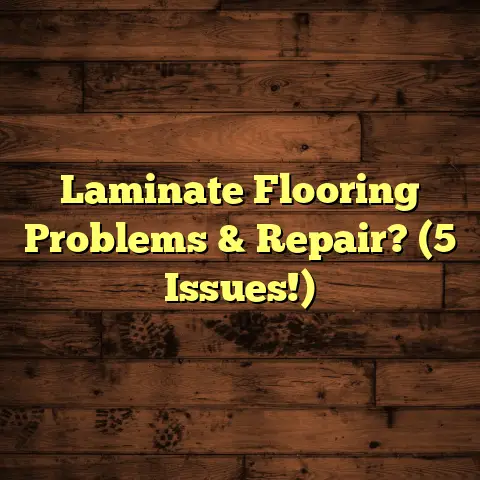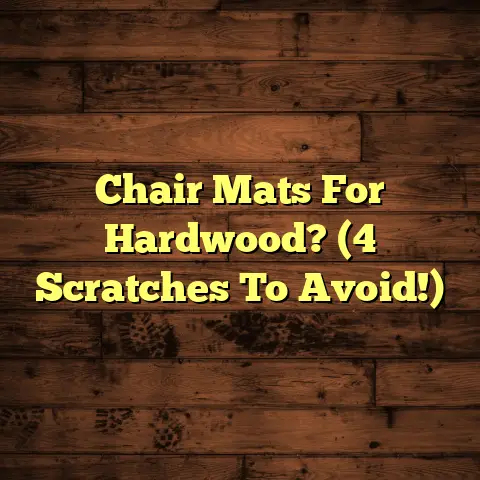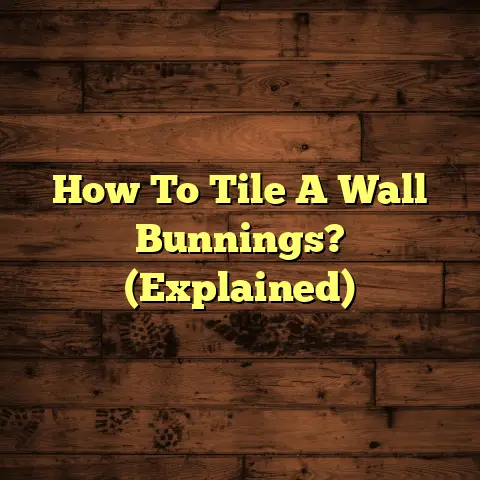Carpet Tape On Wood? (3 Pro Tricks Revealed!)
Floors are a big deal when it comes to your home’s value.
Think about it – when potential buyers walk in, what’s one of the first things they notice?
Yep, the flooring.
A pristine, well-maintained floor can seriously boost your home’s appeal and, ultimately, its resale value.
But life happens, right?
Kids, pets, everyday wear and tear…
It all takes a toll.
That’s where clever solutions like carpet tape come in handy.
Carpet tape can be a lifesaver for securing rugs, preventing slips, and generally keeping your carpets looking sharp.
It’s a temporary fix that can make a big difference.
However, when you have wooden floors, you need to be extra careful.
You don’t want to ruin your wood floor.
That’s why I want to share some insights on how to use carpet tape safely and effectively on wooden floors.
I’ll share some pro tricks I’ve picked up over the years, so you can keep your floors looking fantastic and maximize your home’s resale potential.
Let’s dive in!
Section 1: Understanding Carpet Tape and Its Uses
Definition and Types of Carpet Tape
So, what exactly is carpet tape?
Simply put, it’s an adhesive tape designed to secure carpets and rugs to the floor.
The primary purpose is to prevent slipping, sliding, and wrinkling, which can be both annoying and dangerous.
It’s basically your carpet’s best friend (when used correctly, of course!).
Now, here’s where it gets interesting: There isn’t just one type of carpet tape.
There’s a whole family of tapes, each with its own specialized job.
Let’s break down some of the most common types:
-
Double-Sided Carpet Tape: This is the most common type.
It has adhesive on both sides, allowing you to stick the
carpet to the floor. It’s great for general use and
securing rugs in place. -
Removable Carpet Tape: This type is designed to be
easily removed without leaving residue or damaging the
floor. It’s ideal for temporary installations or situations
where you might want to reposition the carpet later. -
Heavy-Duty Carpet Tape: When you need serious holding
power, heavy-duty tape is the way to go. It’s perfect for
high-traffic areas or securing carpets that tend to shift
a lot. -
Carpet Seaming Tape: While not technically for securing
carpets to the floor, it’s worth mentioning. This tape is
used to join two pieces of carpet together, creating a
seamless look.
Choosing the right tape depends on your specific needs and the type of flooring you have.
For wooden floors, you’ll want to lean towards removable or low-tack options to avoid damage.
Why Use Carpet Tape on Wood?
Why would you even consider using carpet tape on your beautiful wooden floors?
Good question!
There are several compelling reasons:
-
Ease of Use: Carpet tape is incredibly easy to apply.
No special tools or skills are required. You simply cut,
peel, and stick. I’ve seen people secure a rug in under
5 minutes. -
Cost-Effectiveness: Compared to other methods of
securing carpets, like installing tack strips or using
expensive rug pads, carpet tape is a budget-friendly
option. -
Non-Damaging (Potentially): When used correctly and
with the right type of tape, carpet tape can be
non-damaging to wooden floors. Removable tapes are
specifically designed to leave no residue or damage. -
Versatility: Carpet tape can be used on a variety of
wooden floor types, including hardwood, laminate, and
engineered wood. -
Temporary Solution: If you’re renting, staging your
home for sale, or simply want a temporary solution, carpet
tape is perfect. You can easily remove it when needed
without making permanent changes.
However, it’s crucial to choose the right type of tape and follow proper application and removal techniques.
I’ve seen folks use the wrong tape and end up with sticky residue or damaged finishes.
Trust me, it’s not a pretty sight!
Common Scenarios for Using Carpet Tape
So, where does carpet tape really shine?
Here are a few common scenarios where it can be a real lifesaver:
-
Securing Area Rugs: This is probably the most common
use. Carpet tape keeps area rugs from sliding around on
wooden floors, preventing accidents and keeping your rugs
looking neat. -
Preventing Slips and Falls: Slippery rugs can be a
hazard, especially for kids and seniors. Carpet tape adds
an extra layer of security, reducing the risk of slips
and falls. -
Temporary Installations: If you’re decorating for a
party, staging your home for sale, or simply want to
experiment with different rug placements, carpet tape
allows for temporary installations without causing
permanent damage. -
RV and Boat Carpets: Carpet tape is also popular for
securing carpets in recreational vehicles (RVs) and boats,
where movement can cause rugs to shift and bunch up. -
Trade Shows and Events: Exhibitors often use carpet
tape to secure carpets and rugs in their booths, creating
a professional and safe environment for attendees.
In each of these scenarios, carpet tape provides a simple, effective, and affordable solution for keeping carpets in place and preventing accidents.
Section 2: Pro Trick #1 – Preparing the Wooden Surface
Alright, let’s get down to the nitty-gritty.
Before you even think about slapping that carpet tape onto your wooden floor, you need to prep the surface.
This is where many people go wrong, and it can lead to disastrous results.
Trust me, a little preparation goes a long way in preventing damage and ensuring a secure hold.
Cleaning the Floor
Imagine trying to stick tape to a dusty, greasy surface.
It’s not going to work very well, right?
The same principle applies to your wooden floor.
Before applying carpet tape, you need to thoroughly clean the area where the tape will be applied.
Here’s a step-by-step guide:
-
Remove Loose Debris: Start by sweeping or vacuuming the
floor to remove any loose dirt, dust, and debris. Pay
special attention to corners and edges, where dirt tends
to accumulate. -
Wash the Floor: Use a damp mop or cloth with a mild
wood floor cleaner to wash the floor. Avoid using excessive
water, as it can damage the wood. Be sure to wring out the
mop or cloth thoroughly. -
Remove Stubborn Stains: If you encounter any stubborn
stains, try using a specialized wood floor stain remover.
Always test the cleaner in an inconspicuous area first to
ensure it doesn’t damage the finish. -
Dry the Floor: After washing, dry the floor thoroughly
with a clean, dry cloth or towel. Don’t leave any standing
water, as it can seep into the wood and cause damage. -
Let it Air Dry: Allow the floor to air dry completely
before applying carpet tape. This may take several hours,
depending on the humidity and temperature.
A clean floor is essential for proper tape adhesion.
It removes any barriers that could prevent the tape from making direct contact with the wood surface.
Assessing the Condition of the Wood
Now that your floor is sparkling clean, take a closer look.
Are there any imperfections or damage that could affect tape adhesion?
Here’s what to look for:
-
Scratches and Gouges: Deep scratches or gouges can
create uneven surfaces that prevent the tape from adhering
properly. -
Peeling Finish: If the finish on your wooden floor is
peeling or flaking, the tape may lift the finish when
removed, causing further damage. -
Wax Buildup: Excessive wax buildup can create a slippery
surface that prevents the tape from sticking. -
Moisture Damage: If the wood is damp or water-damaged,
the tape may not adhere properly and could even trap
moisture, leading to further damage.
If you find any of these issues, you may need to take remedial action before applying carpet tape.
For example, you could sand down rough areas, refinish small sections, or remove wax buildup with a specialized cleaner.
Addressing these issues will ensure that the tape adheres properly and doesn’t cause further damage to your floor.
Choosing the Right Tape
We talked about the different types of carpet tape earlier, but it’s worth revisiting this topic in the context of wooden floors.
When it comes to choosing the right tape for wood, you need to consider several factors:
-
Adhesive Strength: You want a tape that’s strong enough
to hold the carpet in place, but not so strong that it
damages the finish when removed. -
Removability: Opt for a tape that’s specifically
designed to be removable without leaving residue or
damaging the floor. -
Tack Level: Low-tack tapes are generally safer for
wooden floors, as they have a gentler adhesive that’s less
likely to cause damage. -
Material Compatibility: Check the tape’s packaging to
ensure it’s compatible with wooden floors. Some tapes may
contain chemicals that can damage certain types of wood
finishes.
Based on these factors, here are a few types of carpet tape that are generally considered safe for wooden floors:
-
Removable Double-Sided Carpet Tape: These tapes are
specifically designed for temporary installations and are
less likely to damage the floor. -
Low-Tack Carpet Tape: These tapes have a gentler adhesive
that’s less likely to lift the finish or leave residue. -
Carpet Tape for Hardwood Floors: Some manufacturers
offer tapes that are specifically formulated for use on
hardwood floors.
Always test the tape in an inconspicuous area before applying it to the entire floor.
This will help you ensure that it doesn’t damage the finish or leave any residue.
Section 3: Pro Trick #2 – Applying Carpet Tape Correctly
Okay, your floor is clean, you’ve assessed its condition, and you’ve chosen the right tape.
Now it’s time to get to work!
Applying carpet tape correctly is crucial for ensuring a secure hold and preventing damage to your wooden floor.
I’m going to walk you through the process step-by-step.
Step-by-Step Application Process
-
Measure and Cut the Tape: Use a measuring tape to
determine the length of tape you need. Cut the tape to
size using scissors or a utility knife. -
Apply the Tape to the Carpet: Peel off the backing from
one side of the tape and apply it to the back of the
carpet or rug. Press firmly to ensure a secure bond. -
Position the Carpet: Carefully position the carpet or
rug in the desired location on the wooden floor. -
Peel Off the Remaining Backing: Once the carpet is in
place, peel off the backing from the other side of the
tape. -
Press Down Firmly: Press down firmly on the carpet or
rug to ensure that the tape adheres properly to the wooden
floor. -
Repeat as Needed: Repeat the process as needed to
secure the entire carpet or rug.
Here are a few additional tips to keep in mind:
-
Use Enough Tape: Don’t skimp on the tape! Use enough to
ensure a secure hold, especially in high-traffic areas. -
Apply Tape in a Grid Pattern: For larger carpets or
rugs, consider applying the tape in a grid pattern to
provide even support. -
Avoid Overlapping Tape: Overlapping tape can create
uneven surfaces and prevent proper adhesion. -
Work in Small Sections: Apply the tape in small sections
to prevent it from sticking to itself or other surfaces.
Positioning the Carpet
Positioning the carpet accurately is just as important as applying the tape correctly.
You want to make sure that the carpet lies flat and doesn’t bubble or warp.
Here are a few techniques to help you achieve this:
-
Start at One Edge: Begin by positioning one edge of the
carpet along a wall or other fixed point. -
Smooth Out Wrinkles: As you position the carpet, smooth
out any wrinkles or bubbles to ensure a flat surface. -
Use a Carpet Stretcher: For larger carpets, consider
using a carpet stretcher to help you achieve a tight,
even fit. -
Adjust as Needed: Don’t be afraid to adjust the position
of the carpet as needed to ensure a perfect fit.
Sealing the Edges
Sealing the edges of the carpet with tape is essential for preventing lifting and curling.
This is especially important in high-traffic areas or where the carpet is exposed to moisture.
Here’s how to do it effectively:
-
Apply Tape Along the Edges: Apply a strip of carpet
tape along each edge of the carpet, making sure to overlap
the tape slightly onto the wooden floor. -
Press Down Firmly: Press down firmly on the tape to
ensure a secure bond. -
Trim Excess Tape: Trim any excess tape with scissors or
a utility knife.
By sealing the edges of the carpet, you’ll create a barrier that prevents dirt, moisture, and debris from getting underneath.
This will help extend the life of your carpet and protect your wooden floor.
Section 4: Pro Trick #3 – Removing Carpet Tape Without Damage
Alright, you’ve successfully applied carpet tape to your wooden floor.
But what happens when it’s time to remove it?
This is where things can get tricky.
Removing carpet tape improperly can lead to sticky residue, damaged finishes, and a whole lot of frustration.
But don’t worry, I’m here to guide you through the process and share some pro tips for removing carpet tape without causing damage.
When to Remove the Carpet Tape
First, let’s talk about when it might be necessary to remove carpet tape.
Here are a few common scenarios:
-
Moving: When you move to a new home, you’ll likely need
to remove any carpet tape that’s been used to secure rugs
or carpets. -
Redecorating: If you’re redecorating your home, you
might want to remove the carpet tape to reposition or
replace your rugs. -
Replacing Carpets: When it’s time to replace your
carpets, you’ll need to remove any carpet tape that’s
been used to secure them. -
Cleaning or Repairing the Floor: If you need to clean
or repair your wooden floor, you’ll need to remove any
carpet tape that’s in the way.
Safe Removal Techniques
Now, let’s get to the heart of the matter: How do you remove carpet tape from wood without causing damage?
Here are a few safe and effective techniques:
-
Heat: Applying heat to the tape can help soften the
adhesive, making it easier to remove. You can use a
hair dryer or heat gun on a low setting. Hold the heat
source a few inches away from the tape and move it back
and forth to avoid overheating the wood. -
Solvents: Certain solvents, like mineral spirits or
adhesive remover, can help dissolve the adhesive and
make it easier to remove the tape. Always test the
solvent in an inconspicuous area first to ensure it
doesn’t damage the finish. -
Plastic Scraper: Use a plastic scraper or putty knife
to gently lift the edge of the tape. Avoid using metal
scrapers, as they can scratch the wood. -
WD-40: WD-40 can be surprisingly effective at removing
carpet tape residue. Spray a small amount of WD-40 onto
the tape and let it sit for a few minutes before trying
to remove it. -
Patience: The key to removing carpet tape without
damage is patience. Don’t try to rush the process or
force the tape off, as this can lead to damaged finishes.
Here’s a step-by-step guide to removing carpet tape using heat and a plastic scraper:
-
Apply Heat: Use a hair dryer or heat gun on a low
setting to heat the tape. -
Lift the Edge: Use a plastic scraper to gently lift
the edge of the tape. -
Peel Slowly: Slowly peel the tape away from the wood,
applying heat as needed. -
Remove Residue: If any residue remains, use a solvent
or WD-40 to remove it.
Post-Removal Care
Once you’ve successfully removed the carpet tape, it’s important to care for the wooden floor to prevent any long-term damage.
Here are a few steps to take:
-
Clean the Floor: Use a mild wood floor cleaner to clean
the area where the tape was removed. -
Check for Residue: Inspect the floor for any adhesive
residue. If you find any, use a solvent or WD-40 to
remove it. -
Treat Discoloration: If the tape has caused any
discoloration, you may need to sand and refinish the
affected area. -
Apply Polish or Wax: Apply a polish or wax to the
floor to protect the finish and restore its shine.
By following these post-removal care tips, you can ensure that your wooden floor remains in top condition for years to come.
Conclusion
Alright, we’ve covered a lot of ground today!
We’ve talked about the importance of flooring maintenance for resale value, the benefits of using carpet tape on wood, and the pro tricks for applying and removing carpet tape without causing damage.
Remember, your floors are one of the first things potential buyers notice.
Keeping them in great shape is key to maximizing your home’s appeal and value.
Using carpet tape can be a simple and effective way to secure rugs, prevent slips, and generally keep your carpets looking their best.
But it’s crucial to choose the right type of tape, prepare the surface properly, and follow safe removal techniques to avoid damaging your wooden floors.
I hope the tips and tricks I’ve shared today will help you enhance the longevity and appearance of your flooring.
By taking care of your floors, you’re not only creating a more comfortable and inviting home, but you’re also investing in your property’s future.
So go ahead, give your floors some love!
With a little care and attention, you can keep them looking fantastic and make a great impression on potential buyers.
Thanks for joining me today, and happy flooring!





